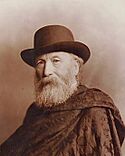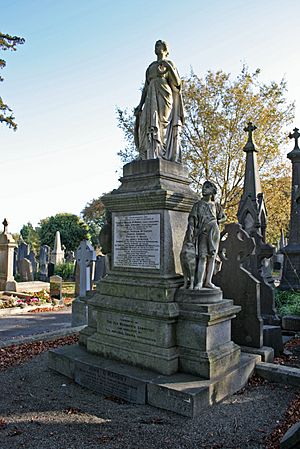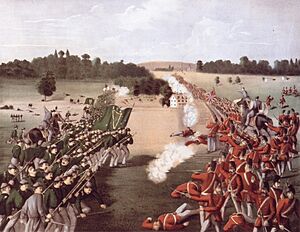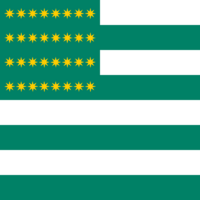Fenian facts for kids
The word Fenian was a general name for two secret groups: the Irish Republican Brotherhood (IRB) in Ireland and the Fenian Brotherhood in the United States. These groups existed in the late 1800s and early 1900s. Their main goal was to create an independent Irish Republic. They wanted Ireland to be a country free from British rule.
In 1867, they tried to work together. They planned attacks on Canada from the United States. At the same time, they hoped for a rebellion in Ireland. The IRB also played a big part in later struggles for Irish freedom. These included the Easter Rising in 1916 and the Irish War of Independence from 1919 to 1921.
Contents
Fenianism: What it Meant
Fenianism was a set of ideas about Irish independence. According to one of its leaders, John O'Mahony, it had two main beliefs. First, Ireland had a natural right to be a free country. Second, this freedom could only be won through a fight or revolution.
The name "Fenian" came from ancient Irish stories. It was inspired by the Fianna, who were legendary groups of warriors. These warriors were linked to a famous hero named Fionn mac Cumhail. Stories about the Fianna are known as the Fenian Cycle.
In the 1860s, some people in Britain used the word "Fenianism" in a different way. They used it to describe any Irish person who wanted change. This included people who simply wanted more rights for farmers. They wrongly called groups like the Tenant Right League "Fenians." These groups did not want a fully independent Ireland or to use force.
Ireland: The Fight for Freedom
James Stephens was a key figure. He had been part of an earlier rebellion in 1848. He lived in Paris and talked with other Irish nationalists. One of these was John O'Mahony in the United States.
Stephens, along with Thomas Clarke Luby, John O'Leary, and Charles Kickham, started the Irish Republican Brotherhood (IRB). This happened on March 17, 1858, in Dublin.
The Fenian Rising in 1867 was not very successful. It was poorly planned and did not have much public support. Many Irish-American officers who came to Ireland were arrested. Small fights around the country were easily stopped by the police and army. After this, some Fenians attacked police officers in Dublin in October 1867.
In 1882, a group from the IRB, called the Irish National Invincibles, attacked important British officials. They killed the British Chief Secretary for Ireland, Lord Frederick Cavendish. This event is known as the Phoenix Park Murders.
United States: The Fenian Brotherhood
The Fenian Brotherhood was the American branch of the IRB. It was started by John O'Mahony and Michael Doheny. Both had been involved in the 1848 rebellion. This group quickly grew in the US. It worked to get Irish Americans to support a fight for freedom in Ireland.
At first, O'Mahony led the group in the US. He sent money to Stephens and the IRB in Ireland. Later, there were disagreements about who should lead. Different groups formed, but they all wanted to help Ireland.
John Devoy wrote that in 1866, different Fenian groups tried to unite. They wanted James Stephens to be their leader. Stephens had escaped from Ireland. He promised that the Irish flag would fly freely by New Year's Day, 1867. Rifles were sent to Ireland, but they arrived too late for the 1867 rebellion.
Canada: The Fenian Raids
In Canada, "Fenian" refers to a group of Irish radicals from the 1860s. They were part of the American Fenian Brotherhood. They tried several times to invade parts of British colonies in Canada. These attacks continued even after the colonies joined together to form Canada.
The main goal of these raids was to take Canada hostage. They hoped this would force the United Kingdom to give Ireland its independence. Because of these invasion attempts, very few Irish people in Canada supported the Fenians.
The danger from the Fenian raids was important for Canada. It made the British colonies in North America think about working together for defense. This idea helped lead to the creation of Canada as a country.
England: Fenian Actions
The Fenians in England were a big concern for political stability. In the late 1860s, the IRB had a main base in Lancashire. The IRB's Supreme Council, which was like a temporary government, was reorganized. It had members from different parts of Ireland and England.
On November 23, 1867, three Fenians were executed in Salford. They were William Philip Allen, Michael O'Brian, and Michael Larkin. They became known as the Manchester Martyrs. They were executed for attacking a police van to free other Fenians.
On December 13, 1867, Fenians exploded a bomb near Clerkenwell Prison in London. They wanted to free one of their members. The explosion damaged nearby homes, killed 12 people, and injured 120. No prisoners escaped. This bombing made the public very angry. It made it harder for Ireland to gain more self-rule or independence. The IRB leaders said they did not approve of the bombing.
Fenians also set off three bombs on the London Underground between 1883 and 1885. They were also thought to be responsible for a bomb at Aldersgate Street station in 1897. This bomb sadly killed two people.
Australia: Fenian Connections
In 1868, an Irishman named Henry O'Farrell tried to attack the Duke of Edinburgh. The Duke was the second son of Queen Victoria and was visiting Sydney. O'Farrell claimed to be a Fenian, but he was probably acting alone. He was executed on April 21, 1868. The Duke recovered, but the attack was used by a politician to cause problems between Catholics and people of Irish background.
Later in 1868, the Hougoumont arrived in Western Australia. It was the last ship to bring prisoners to Australia. On board were 62 Fenian prisoners who had been convicted in England. Over the next ten years, most were set free. Many chose to go to America.
By 1876, only six Fenian prisoners were left. That year, they were freed in a brave rescue mission. The IRB in the United States planned it. A ship called Catalpa sailed from Massachusetts to Fremantle, Australia. This was a very long journey of about 12,000 miles. The ship took the men back to the United States. This rescue was famous worldwide and inspired many songs.
Fenian: Used Today
Northern Ireland
In Northern Ireland, some people use "Fenian" as a rude word for Irish Catholics. For example, in 2012, a politician was criticized for using the term.
Scotland
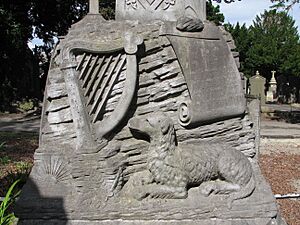
The word "Fenian" is used in a similar way in Scotland. During Scottish football games, it is often aimed at supporters of Celtic F.C.. Celtic Football Club has strong ties to the Catholic Irish people who moved to Glasgow. Because of this, the club is linked to Irish nationalism. The Irish flag is often seen at their matches.
The term is now strongly connected to the rivalry between Celtic and Rangers. Using the term as a religious insult used to have legal penalties in some situations.
Australia
In Australia, "Fenian" can be used as a negative term. It is sometimes used for members of the Australian Labor Party (ALP) who want Australia to become a republic. This means they want Australia to have its own head of state, not the British monarch. In 2006, a politician named Michael Atkinson used the term. He called some ALP members "Fenians and Bolsheviks" because they wanted to remove titles linked to the Crown.
Images for kids




